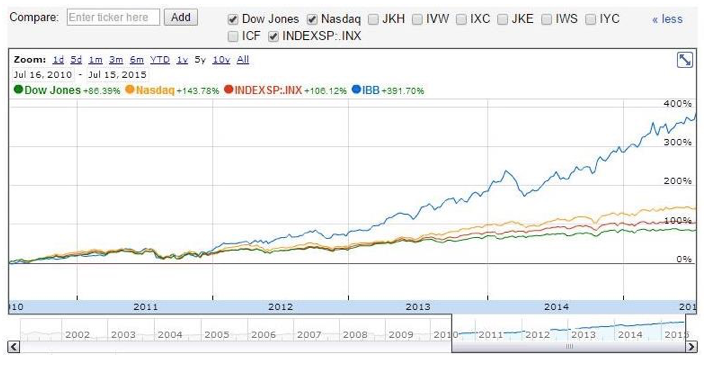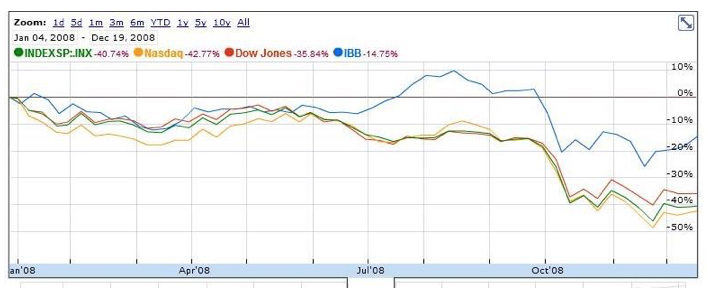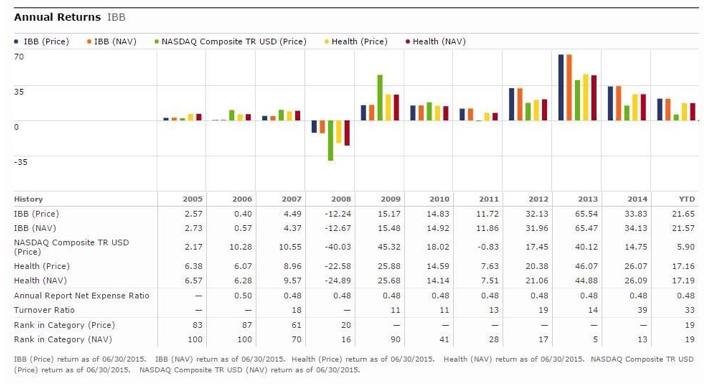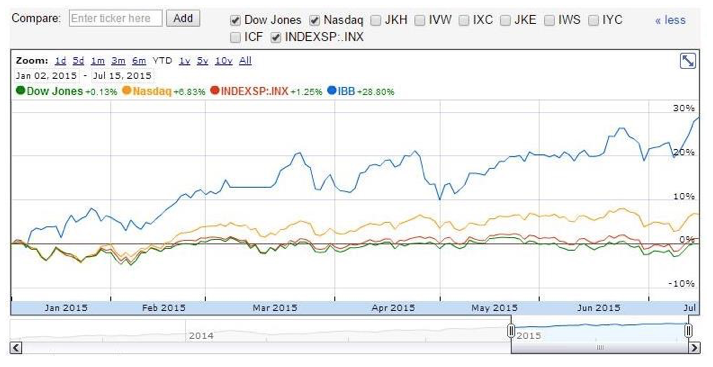Introduction
The biotechnology cohort has transformed into a secular growth sector witnessed by spectacular performance in the face of bull and bear markets as well as economic troubles domestically and abroad. The biotechnology sector has been on an unprecedented performance streak in both annual and cumulative performance over the past 10 years and accentuated during the latest 5-year timeframe. The biotechnology sector can be highly volatile, however I posit that this cohort has established itself as a secular growth sector and thus doesn't fit the mantra of high-risk high-reward based on annual and cumulative performance throughout any market condition. I content that long-term data support this secular viewpoint without the perceived inherent high-risk. Short sellers contend that the sector is overvalued and frothy while its multi-year run has resulted in a bubble imminent of bursting. Some commentators have recommended shorting the sector or relinquishing portfolio positions with exposure to the biotechnology sector altogether. In brief, I'll be using The iShares Nasdaq Biotechnology (IBB) as a proxy to substantiate this thesis. In brief, IBB holds 150 biotechnology firms listed on the Nasdaq with a minimum market capitalization of $200 million thus spanning small, mid and large-cap companies. Greater than ~30% of assets are devoted to small and mid-cap growth names while ~65% is devoted to large-cap growth names. These companies are involved in early clinical development at the forefront of innovation and research to drive the development and potential commercialization of drugs targeting a variety of diseases and unmet medical needs domestically and abroad.
High-Level Overview
• The Biotechnology cohort has solidified itself as a secular growth sector over the past decade while defying market downtrends in the face of economic woes domestically and abroad
• Using IBB as a proxy for the Biotechnology cohort, this sector doesn't fit the mantra of high-risk high-reward based on annual performance throughout bull and bear markets
• Long-term data on this cohort supports very high returns without the perceived high risk
• During the market crash of 2008, IBB outperformed the S&P 500, Nasdaq and Dow Jones by 24.8%, 27.8% and 19.7%, respectively
• Over the past 5 years through 2015 thus far, IBB has posted an average annual return of 33%
• Over the past 10 years IBB has cumulative returns of over 425%, unparalleled by an any major index
The biotech secular growth
The returns for IBB have been very impressive to say the least in both annual and cumulative performance, unparalleled by any major index. Over the past 10 and 5 year timeframes, IBB has posted cumulative returns of over 425% and 390%, respectively. These results are unrivaled by any major index, outperforming on a 10 year cumulative basis of 352%, 285% and 353% for the S&P 500, Nasdaq, and Dow Jones respectively (figure 1). These returns are accentuated during the previous 5 years. IBB notched cumulative returns of 391%, outperforming the S&P 500, Nasdaq and Dow Jones by 285%, 247% and 305%, respectively (figure 2). IBB has cumulatively outperformed all indices by roughly 3-fold and 2.5-fold over the 10-year and 5 -year timeframes, respectively (figures 1 and 2).

Figure 1 – Google Finance comparison of IBB returns relative to the S&P 500, Nasdaq, Dow Jones over the previous 10 years

Figure 2 – Google Finance comparison of IBB returns relative to the S&P 500, Nasdaq, Dow Jones over the previous 5 years
Biotech has outperformed during bear markets
IBB has displayed impressive resilience in the face of the market crash in 2008, the bear markets of 2011 and the choppy market thus far in 2015. During the market crash of 2008, IBB posted an annual return of -12.2% while the S&P 500, Nasdaq and Dow Jones posted returns of -37.0%, -40.0% and -31.9%, respectively (figures 3 and 4). During the bear market of 2011, IBB posted an annual return of 11.7% while the S&P 500, Nasdaq and Dow Jones posted returns of 2.1%, -0.8% and 8.4%, respectively (figures 3 and 4). Thus far during the choppy market of 2015, IBB posted an annual return of 28.8% while the S&P 500, Nasdaq and Dow Jones posted returns of 1.3%, 6.8% and 0.1%, respectively (Figure 5). These data suggest that IBB outperforms during bear markets to establish itself as a secular growth sector.

Figure 3 – Google Finance comparison of IBB annual performance relative to the S&P 500, Nasdaq and Dow Jones during the market crash of 2008

Figure 4 – Morningstar comparison of IBB annual returns relative to the Nasdaq over the previous 10 years

Figure 5 – Google Finance comparison of IBB annual performance thus far in 2015 relative to the S&P 500, Nasdaq and Dow Jones
The merger and acquisition activity provides a growth catalyst
The biotechnology sector can be volatile and this can be attributable to multiple scenarios from drug approvals, drug failures, acquisitions, restructuring, divestitures, partnerships, patent lose, regulatory challenges, etc. There's intrinsic volatility within the sector since so much is contingent upon a common goal of obtaining drug approvals and a subsequent revenue stream to fund the future pipeline. In pursuit of this common goal and to evolve to changing market conditions, companies within the biotechnology sector commonly initiate partnerships and become acquisitive. The former item is of particular interest to investors, such that acquisitions can add value to shareholders in a meaningful manner. Acquisitions play a large part in volatility, some in the form of hostile takeover attempts such as Valeant (VRX) in the unsuccessful purchase of Allergan (AGN) to later be acquired by Actavis (ACT). AbbVie agreed to buy Pharmacyclics (PCYC) in a $21 billion deal. Companies with emerging and promising pipelines such as Receptos (RCPT) have been rumored as a potential acquisition target for some time. Earlier this week Celgene (CELG) agreed to acquire Receptos for $7.2 billion in cash or $232 per share. Teva (TEVA) has placed a $40 billion bid for Mylan (MYL) recently as well. Valeant acquired to buy the financially distressed immunotherapy company Dendreon (DNDN) in bankruptcy court for $495 million. These acquirers pay healthy premiums for potential pipelines and intellectual property. This consolidation bodes well for the entire sector whereby removing competition and combining or driving pipelines for future growth and innovation.
Exposure to the biotechnology sector
The companies that constitute the biotechnology cohort are at the forefront of innovation across many traditional therapeutic areas including oncology, virology and immunology as well as emerging therapeutic areas via immunotherapies and genomics-based therapies. The aggressive investment in research and development within the sector has paved way for many blockbuster approvals. Along with these approvals often times comes with lucrative rewards for shareholders. Due to the high-risk and difficulty of identifying one company in hopes that a clinical stage drug candidate comes to fruition, IBB offers exposure to the entire sector and mitigates that risk by default. This may serve as a viable alternative to those unwilling to take on a single company investment strategy while still maintaining portfolio exposure to this secular growth sector. Considering the long track record of innovative treatments and market performance, IBB may serve as a great companion holding for any long portfolio with a long-term time horizon to buffer any volatility within the biotechnology sector.
Summary
I posit that the biotechnology cohort has established itself as a secular growth sector and doesn't fit the mantra of high-risk high-reward based on annual performance throughout bull and bear markets. Year-to-date the biotech cohort, using IBB as a proxy, has once again defied the market returning over 28% and outpacing all major indices by greater than 20%. Data suggests, provided a long-term position that volatility within the biotech sector is negated by its long-term performance that is unparalleled by any major index. This sector provides high returns unrivaled by any major index with moderate risk (based on its resilience during the bear markets of 2008 and 2011 and thus far in 2015) and volatility. IBB may serve as a great companion holding for any long portfolio desiring exposure to the biotechnology sector with a long-term time horizon.
Noah Kiedrowski
INO.com Contributor - Biotech
Disclosure: The author currently holds shares of IBB and is long IBB. The author has no business relationship with any companies mentioned in this article. He is not a professional financial advisor or tax professional. This article reflects his own opinions. This article is not intended to be a recommendation to buy or sell any stock or ETF mentioned. Kiedrowski is an individual investor who analyzes investment strategies and disseminates analyses. Kiedrowski encourages all investors to conduct their own research and due diligence prior to investing. Please feel free to comment and provide feedback, the author values all responses.


Sir,
With Canadian $ being 30% cheaper than US$, how would you suggest investing in IBB or any other US stock ? Greatly appreciate your help in this predicament Best wishes.
A Bhasin
A Bhasin
IBB has been on an impressive streak as discussed above and initiating a position at these levels may not be an ideal entry point however if interested in biotech, IBB may provide the diversification needed to mitigate the volatility within the sector. The ETF route removes some of the guesswork involved in selecting a single stock via exposure to a specific cohort (i.e. QQQ for technology). In terms of individual stocks, I look for an attractive P/E ratio, high growth relative to its industry, share buybacks coupled with dividends and an acquisitive mindset. Apple, CVS and Home Depot are high-quality names that fit this criteria in my opinion.
Thanks, Noah
Hello Noah,
Thank you for your quick reply.
You have NOT answered the real question. The exchange rate between US $ and Canadian $. The latter is 30 cheaper than the US$, which means I have to pay 30% more for any stock that is listed in the US market. As the Canadian $ strengthens, I will lose money unless the stocks appreciate more than 30%...I stand to loose in currency exchange. What advice do you give to your clients in Canada or other countries. Should appreciate your help answering this. Thanks again and best wishes.
Arun
Hi Arun
I am not familiar with the Canadian stock exchange, do they offer US equivalents (e.g. Roche is offered on the US exchange via ticker symbol RHHBY) to circumvent the exchange disparity? Even Valeant is offered on the US exchange via VRX although it's a Canadian company. Explore that scenario first however the currency disparity may be difficult to navigate since you convert everything back into Canadian currency. Alternatively, if you invest $1,000 (Canadian) and thus $700 US into a stock or ETF and make a 15% profit to yield $805 US, convert that back to Canadian currency and you $1,150. This all be the same relatively speaking assuming currency remains static which is not the case as we know. A difficult situation when you're considering currency and foreign stock investing. An ETF issued via a Canadian brokerage firm with exposure to the US may be an alternative as well.
Noah